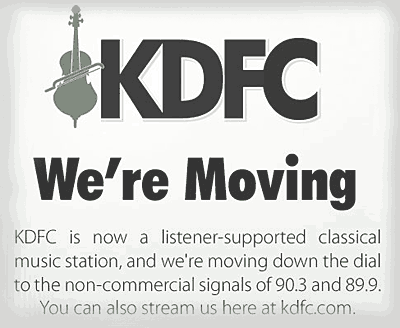Commercial KDFC, one of the last of its kind
San Francisco’s classical station becomes offspring of L.A.’s KUSC
A subsidiary of L.A.’s classical music giant, KUSC, has organized a new pubradio nonprofit to operate San Francisco’s 63-year-old classical stalwart, formerly commercial KDFC.
In the complex deal announced Jan. 18 [2011], KDFC keeps its air personalities and moves to a pair of new and weaker frequencies. Its former owner, Entercom Communications, is redeploying its old 102.1 MHz signal to simulcast Entercom’s classic rock station, KUFX, in San Francisco and San Jose.
Brenda Barnes, KUSC president, says her licensee, the University of Southern California, spent more than $6 million to buy two frequencies for the San Francisco classical station — 90.3 MHz, formerly college station KUSF at the private University of San Francisco, and 89.9 MHz, formerly Christian music outlet KNDL, from Howell Mountain Broadcasting Co.
KDFC was the country’s last commercial classical station that was run like a commercial station, Barnes says. The L.A. station approached Entercom to see if it would work out a “managed transition,” the news release says.
Even with two signals, the classical station will reach less of the Bay Area, with a particularly weak reach into the South Bay, according to Bill Lueth, KDFC p.d. Serving Silicon Valley down there is crucial, he says. Barnes says KDFC is already looking for a third frequency. It also has applied to move the 90.3 signal to Mount Beacon, where its previous transmitter was located.
The only financial transaction with Entercom, Barnes says, is a five-year agreement to rent space and buy tech services from it.
Lueth becomes president of the new KDFC licensee, Classical Public Radio Network — a name recycled from KUSC’s former syndication effort. Public Radio Capital, which aided the transition, will be a 10 percent owner of the licensee, Barnes says.
Students at the university protested the sudden closing of KUSF, a legendary alternative music outlet. On Jan. 18, when the deal went public, KUSF staffers were surprised to learn the station would shut down that day, says Edna Barron, a board operator. The KDFC announcement said the university will continue to operate KUSF on the Internet. [Students are protesting the sale by appealing to the San Francisco Board of Supervisors and mounting a Feb. 1 rally.]
According to tales of KDFC’s early years that Lueth has heard, the announcers spun records in a studio near its tower on Mount Beacon, with a view of the Bay below them. One of the founders, Ed Davis, managed the station until the early 1990s, playing recorded dayparts on rotated tapes. Bonneville Broadcasting bought KDFC in 1997 and began running it “like a real radio station,” says Lueth, who arrived during that period. “We focused on what people most like about classical music and what they don’t like about classical radio.” It was soon the No. 1 music station in the city, and it often ranked in the top five until it was brought low by people meters.
Comments, questions, tips?
Copyright 2011 American University

